test-003-How do centralized capital forces manipulate decentralized markets in Web3? This article offers an in-depth analysis of the centralization of power trap, the four mechanisms of market manipulation, and the strategies and impact of centralized exc
The article offers an in-depth analysis of the power concentration trap, the four mechanisms of market manipulation, and how centralized exchange (CEX) capital is positioned and influences the Perp DEX sector.Chapter 1: Disguised Power—The Paradox of Technological Decentralization and Power Centralization
The core innovations of modern Perp DEXs are rooted in smart contract execution, on-chain transparency, and user self-custody. These technological strengths serve as a “decentralized” shield, yet often obscure a deeper concentration of power.
1.1 The Power Concentration Trap: Implicit Monopoly in Economic Models and Governance Structures
Although projects claim community governance, token allocations establish a centralized power structure from inception. Most governance tokens are held by founding teams, early investors, and VCs, reducing so-called “democratic governance” to a performance for a select few major holders.
More critically, liquidity is the lifeblood of Perp DEXs, yet professional market makers and institutional LPs tightly monopolize it. Regular users struggle to compete against the “Matthew effect” in fee sharing and governance rewards, while high proposal costs further exclude smaller investors from governance, making democracy a mere illusion.
Chapter 2: The Invisible Hand—Market Manipulation Through Four Mechanisms
Centralized capital does not directly attack technical architecture. Instead, it achieves deep market and user control by establishing structurally unequal mechanisms.
2.1 Monopoly: Capital-Driven Oligopoly Market Structure
By 2025, the Perp DEX market exhibits remarkable concentration: the top four platforms—Hyperliquid, Aster, Lighter, and edgeX—collectively control 84.1% of market share.
This extreme concentration is not a result of natural market selection but is driven by capital screening and favoritism. For example, Aster secured nearly 10% of the market shortly after its TGE, demonstrating that background and capital far outweigh technological innovation. Large platforms leverage scale to attract more fees and resources, creating a positive feedback loop and virtually insurmountable liquidity barriers. In a worsening funding environment, this oligopoly is further entrenched, leaving little room for new entrants.
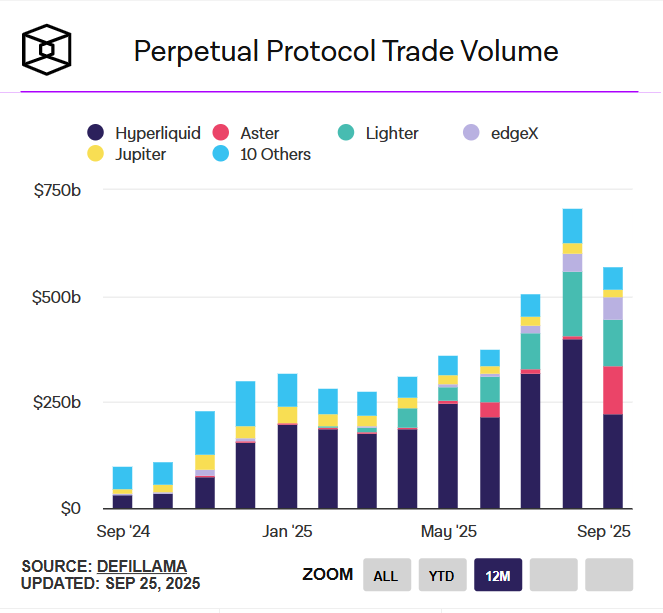
source: theblock
2.2 Intervention: Dual Standards in Governance and Interests
The most severe form of centralized governance is selective intervention. Two classic Hyperliquid cases clearly illustrate how procedural justice collapses in the face of platform interests.
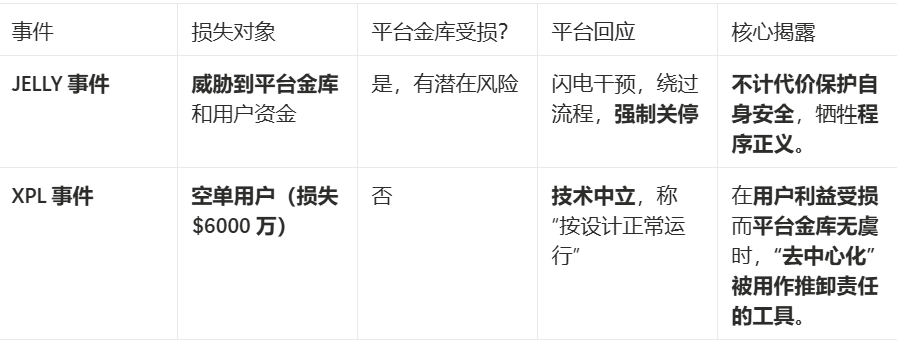
The platform does not decide whether to intervene, but rather exercises centralized authority selectively to protect its own interests. User losses of tens of millions of dollars are dismissed as “market risk,” while potential platform losses trigger emergency actions that undermine decentralization principles.
JELLY Incident—Rapid Intervention: When the JELLY token faced major price manipulation, directly threatening platform liquidity and user vault funds, Hyperliquid responded with unprecedented speed. Validator nodes swiftly reached emergency consensus, bypassed normal governance, initiated an on-chain vote, and forcibly closed profitable orders, shutting down relevant manipulation accounts. The platform claimed this was necessary to protect user vault funds, and the process demonstrated exceptional execution efficiency.
XPL Incident—Apathetic Response: In stark contrast, when manipulators executed a coordinated short squeeze in the XPL market, profiting over $46 million and causing user losses of about $60 million (far exceeding the $11 million loss in the JELLY incident), Hyperliquid’s stance was completely different.
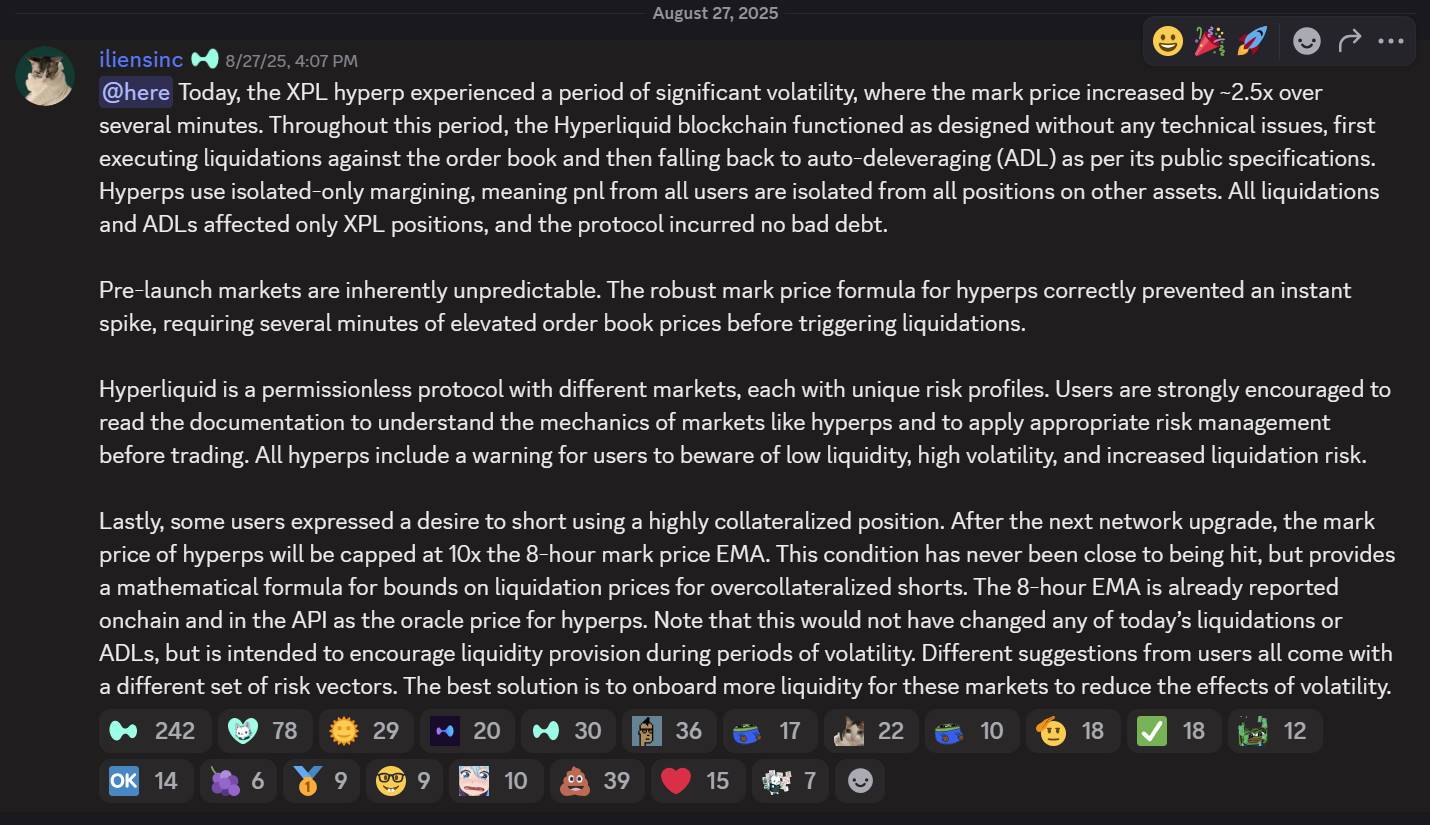
source: hyperliquid discord
On its official Discord, the platform responded: “The XPL market experienced significant volatility, but Hyperliquid blockchain operated as designed, with no technical issues. Liquidation and auto-deleveraging mechanisms were executed per public protocol, and since the platform uses a fully isolated margin system, this incident only affected XPL positions. The protocol incurred no bad debt.”
In this capital-driven feast, manipulators exploited Hyperliquid’s structural vulnerabilities:
- Extreme on-chain transparency enabled precise calculation of required funds and expected outcomes;
- The isolated oracle system meant XPL on Hyperliquid used an independent pricing mechanism, allowing manipulators to control prices within this “walled garden” without external exchange price pressure;
- They targeted an unlisted “paper contract” token, avoiding spot delivery constraints;
- They chose the weakest liquidity window with precision.
Dual-Standard Logic: This starkly different treatment reveals a clear calculation: JELLY threatened the platform treasury and triggered intervention; XPL harmed only users, leaving the treasury untouched, so it was ignored. Platform fund security always takes priority, and so-called decentralization principles are mere window dressing unless core interests are at risk. The $60 million user loss is seen as “market risk,” while potential platform losses justify emergency actions that breach decentralization.
2.3 Structure: Protocol-Level Privilege and Liquidity Monopoly
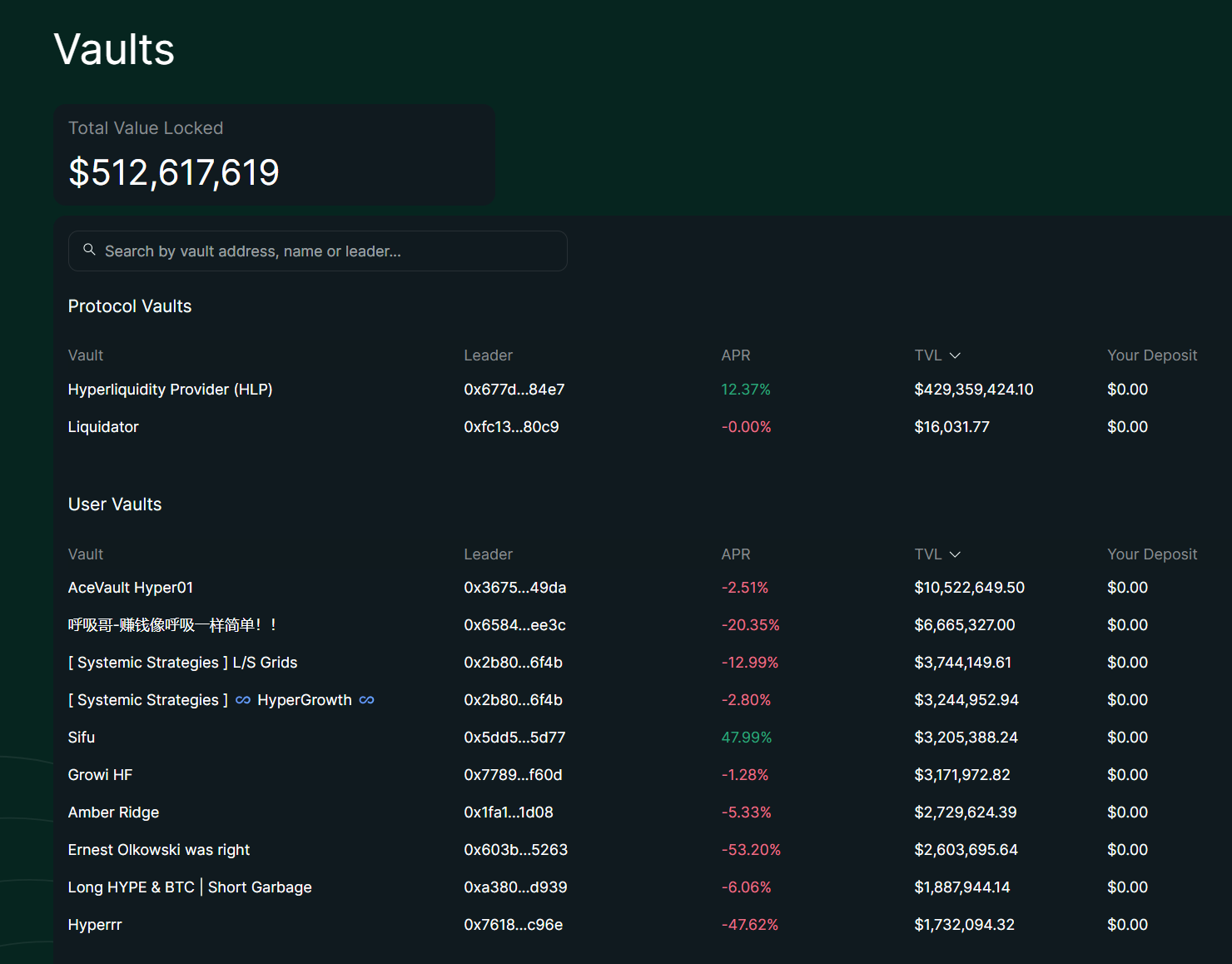
source: hyperliquid
According to the latest data, Hyperliquid’s total TVL stands at $512 million, with the protocol treasury HLP holding $429 million—84% of the total. HLP has become the protocol’s “shadow central bank” or “privileged class.” In contrast, all User Vaults combined hold about $83 million, dispersed across hundreds of independent vaults.
Deep Dive: HLP System Advantages
- Liquidation Monopoly: HLP has exclusive liquidation rights. When leveraged positions are liquidated and the order book cannot fully match, HLP absorbs the remaining positions at roughly 2x leverage, gradually closing them via market-making strategies. This prevents cascading liquidations and channels liquidation profits directly to HLP holders. User Vaults, by contrast, cannot participate in backup liquidation and are limited to custom trading strategies.
- Fee-Sharing Structural Advantage: HLP receives a fixed 45% of platform trading fees, providing stable passive income proportional to trading volume. In H1 2025, HLP captured a significant share of platform revenue through this mechanism, while User Vaults rely solely on Leader strategy performance, with no fixed share rights.
- Collective Risk Buffer: HLP pools over $400 million, sharing risk collectively. Off-chain strategy optimization further reduces volatility. HLP’s volatility is far below BTC’s 45%, maintaining relative stability in all market conditions, with an annualized yield of about 51%. User Vaults are more vulnerable to single strategy failures.
Systemic Constraints on User Vaults
- Information Disadvantage: User Vault Leaders have limited access to market data and cannot access order flow or microstructure information like HLP. HLP’s protocol-level integration allows real-time data feeds, while User Vaults rely on on-chain queries and are prone to latency.
- Execution Efficiency Gap: In Hyperliquid’s sub-second environment, User Vaults face significant latency, especially in high-frequency trading or arbitrage. Leaders can adjust off-chain, but on-chain execution requirements slow their response, making it easier to miss opportunities compared to HLP’s infrastructure priority.
- Profit Pressure from Cost Structure: Leaders charge a 10–20% management/performance fee, directly reducing depositor returns. This increases operational pressure, especially in volatile markets. HLP has no such fees and shares collective PnL only.
- Strategy Limitations from Transparency: On-chain execution requires all positions and trades to be public, improving auditability but limiting strategy flexibility and confidentiality. HLP’s “transparent opacity” (off-chain strategies + on-chain positions) better balances both.
These systemic advantages make HLP the platform’s “default market maker,” accounting for 84% of TVL. User Vaults’ constraints result in most 30-day PnLs being negative (–2.51% to –53.20%), with TVL at just 16%. This structural gap is evident not only in returns but in the implicit inequality between protocol-level and user-level participants.
2.4 Infiltration: The “Rebranding” Game and Ecosystem Capture by CEX Capital
Binance Empire’s Expanding Reach
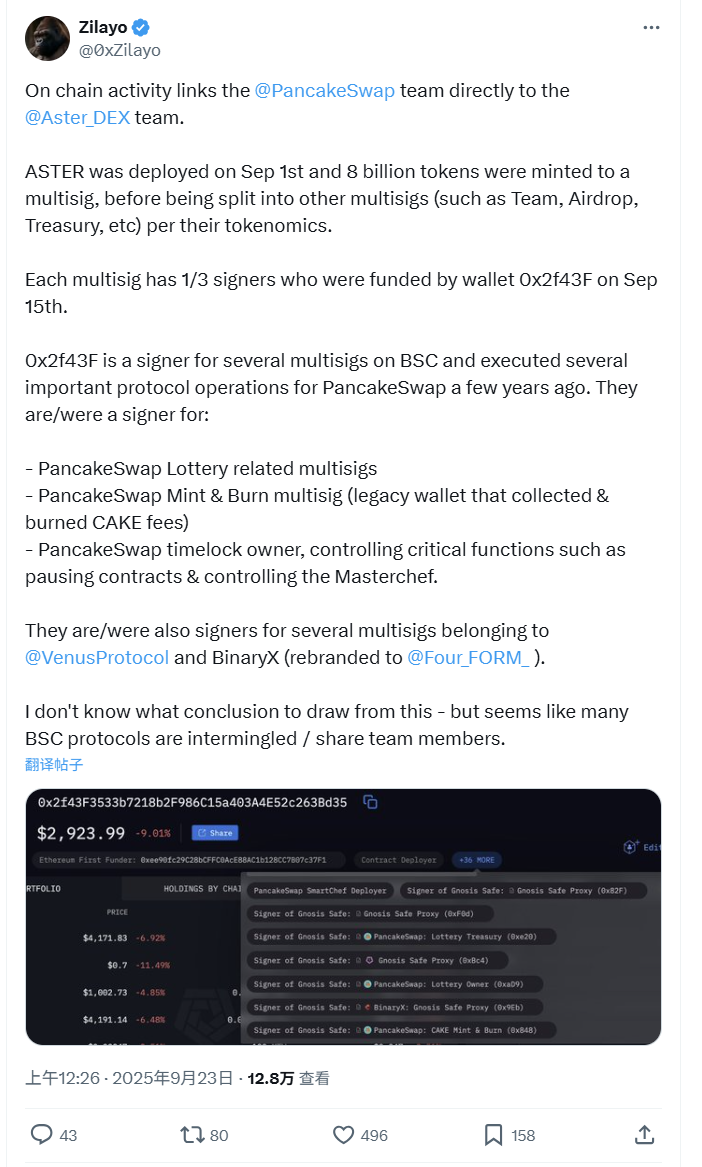
source: @ 0xZilayo & @ awesomeHunter_z X
On-chain investigators @ 0xZilayo and @ awesomeHunter_z have revealed:
The recent explosion of aster and pancakeSwap is driven by the same team.
Core controlling wallet: 0x2f43F3533b7218b2F986C15a403A4E52c263Bd35
Scope of control:
- Aster Treasury multisig contract: 0xEf0791f8dF081c7e6374EE6e9F4c3aBA7C1b1852
- PancakeSwap: direct involvement in CAKE token mint/burn
- Venus Protocol: BSC lending protocol multisig controller
- Aster governance: token deployment, airdrops, team wallets, and other core operations
This is not mere “association,” but different projects operated by the same team.
This also explains why CZ has been actively promoting Aster: it’s not just investment backing, but direct promotion of an internal Binance project. CZ’s tweets are essentially “self-dealing” marketing.
Personnel Network: Binance Executive Project Assignments
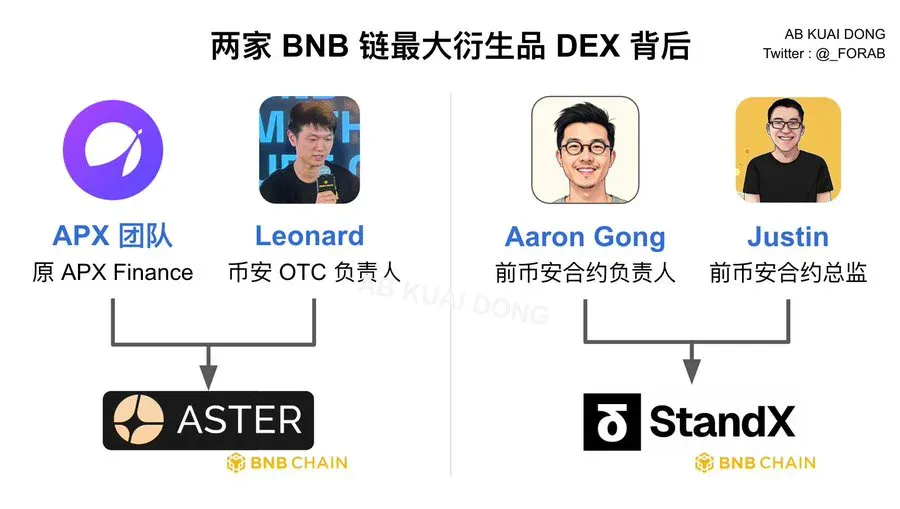
source: @ _FORAB X
Aster team:
- APX team: core members from former APX Finance
- Leonard: Binance OTC head, overseeing block trades and institutional clients
StandX team:
- Aaron Gong: former Binance derivatives head
- Justin: former Binance derivatives director
Dual-Headed Monopoly Design:
- Product differentiation: Aster targets cross-chain diversity; StandX focuses on BNB ecosystem
- Risk diversification: separate legal entities and technical architectures reduce regulatory risk
- Full market coverage: no matter which succeeds, Binance ultimately benefits
Other CEXs’ Strategic Moves
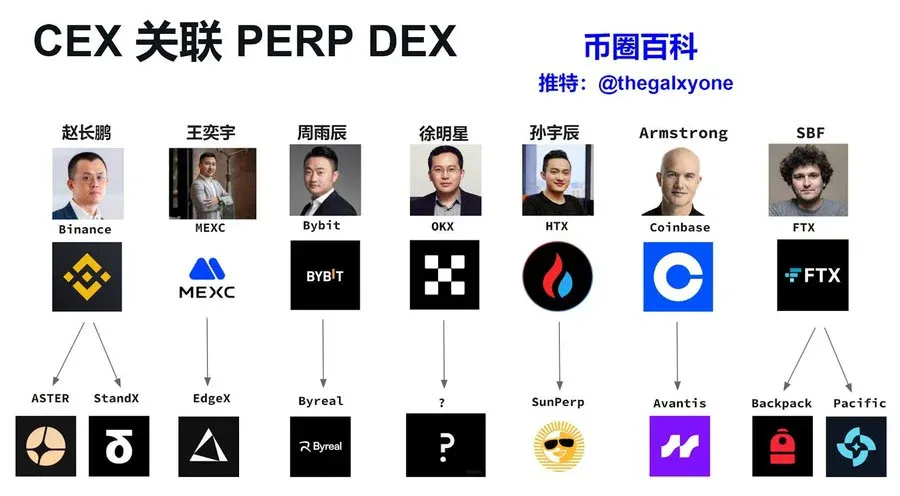
source: X Crypto Encyclopedia @ thegalxyone
Perp DEX strategies by major CEXs:
- MEXC → EdgeX: Under Wang Yiyu, MEXC is known as the “king of small tokens.” EdgeX focuses on ZK-Rollup perpetual DEX, aligning with MEXC’s flexible token listing. EDGEX is a former executive’s startup, and both sides remain closely linked.
- Bybit → Byreal: Bybit has deep derivatives expertise; Byreal inherits Bybit’s perpetual contract technology, using “decentralization” as regulatory cover.
- HTX → SunPerp: Justin Sun’s HTX (formerly Huobi) leverages the TRON ecosystem; SunPerp uses TRON’s low-cost advantage, reflecting Sun’s “ecosystem closed loop” strategy.
- Coinbase → Avantis: Under Armstrong, Coinbase represents the US compliance path. Avantis focuses on RWA perpetuals, aligns with US regulations, and leverages the Base chain for tech-compliance balance.
- FTX → Backpack & Pacific: Despite SBF’s collapse, FTX’s technical DNA persists. Former FTX teams have joined various projects; Backpack and Pacific may have inherited some FTX technical assets.
CEX Motives for Perp DEX Expansion
- CEX Strategic Landscape: From Binance’s investments in Aster and StandX, to MEXC incubating EdgeX, and Coinbase’s deployment of Avantis, all CEXs share core motives: regulatory risk avoidance (via “decentralization”), defending market share, and capturing the next wave of DeFi innovation.
- Harsh Reality: CEXs leverage shared technology, unified market-making, and traffic redirection to move users from CEXs to affiliated Perp DEXs, keeping user activity within the same capital group’s ecosystem. The “decentralization” revolution may simply be a “capital rebranding” exercise by traditional centralized powers.
Chapter 3: The End of the Ideological Debate
“Technological decentralization, power centralization” is now the new normal for Perp DEXs.
Top platforms follow DeFi principles in technical architecture, but in practice are deeply controlled by CEX capital and a handful of oligarchs. They use decentralization narratives as tools to achieve efficiency and regulatory arbitrage.
The key to winning in the Perp DEX sector is no longer ideological purity, but who can best balance decentralized infrastructure with centralized operational efficiency to deliver a CEX-grade user experience. For mainstream users, trading speed, capital efficiency, and seamlessness now outweigh the pursuit of pure decentralization ideals.
Future competition will therefore center on who can build sustainable value capture mechanisms while continuing to execute efficient centralized capital strategies under the “decentralization” banner.
Statement:
- This article is reproduced from [TechFlow], copyright belongs to the original author [WolfDAO]. If you have any concerns about this reprint, please contact the Gate Learn team, and we will address it promptly according to relevant procedures.
- Disclaimer: The views and opinions expressed in this article are solely those of the author and do not constitute investment advice.
- Other language versions of this article are translated by the Gate Learn team. Without explicit reference to Gate, it is prohibited to copy, distribute, or plagiarize the translated article.
Related Articles

In-depth Explanation of Yala: Building a Modular DeFi Yield Aggregator with $YU Stablecoin as a Medium

BTC and Projects in The BRC-20 Ecosystem

What is Blum? All You Need to Know About BLUM in 2025

What Is Ethereum 2.0? Understanding The Merge

Reflections on Ethereum Governance Following the 3074 Saga
